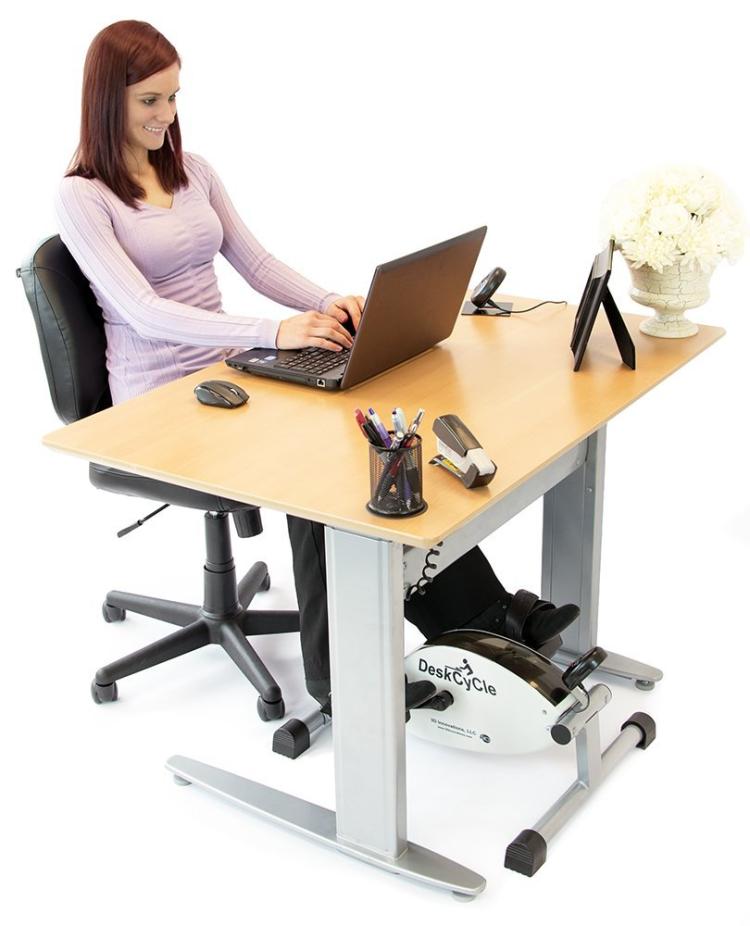If ‘sitting is the new smoking,’ can desk workers snuff out risk?
CU Boulder research team has found marked health benefits from electric-assist commuter bikes and ‘passive-cycling’; now, the team is studying an under-the-desk cycle that shows similar promise
Desk jobs may be literally killing us, but an emerging area of research suggests that sedentary people can reap big health benefits from even small amounts of physical movement.
The results from studies of electrically assisted commuter bikes and from “passive cycling,” in which people’s legs are moved for them, are helping researchers from the University of Colorado Boulder determine how sedentary folks could improve their health without having to start running marathons.

William Byrnes, left, and James Peterman with a pedelec electric-assist bicycle, which they found to help improve cardiovascular health and blood-glucose levels. CU Boulder file photo.
Long periods of sitting are linked with obesity, cardiovascular disease, diabetes and even cancer. Those who are sedentary are at highest risk, and regular exercise might reduce but not eliminate the danger.
Some say “sitting is the new smoking,” but identifying the problem is easier than finding a solution. Many jobs require hours of sitting at a desk, plus more sitting during a long commute.
The CU Boulder research team includes James Peterman, a PhD candidate, with Associate Professors Rodger Kram and William Byrnes in the Department of Integrative Physiology.
Last year, the team found that people who regularly rode an electric-assist bicycle attained improved cardiovascular health and better blood-sugar levels. These benefits didn’t require that participants hit the gym.
In that study, the researchers recruited non-exercising volunteers who commuted by car. At least three days a week, the volunteers left their cars at home and rode an electric-assist bike, called a “pedelec,” for 40 minutes per day.
The pedelecs’ electric motors help move the bikes only when riders spin the pedals. This means riders can’t just push a button and cruise to work on an electric scooter; they must engage their muscles, which resulted in improvement of selected markers of good health.
Separately, Peterman and his colleagues have studied passive cycling, in which a motor spins the pedals on a cycle situated near a chair. “You’re not volitionally pedaling,” Peterman observed. The pedals move your legs for you.
While most wouldn’t think of passive cycling as “exercise,” Peterman and his colleagues found that passive cycling doubled the research volunteers’ energy expenditure as compared with sitting. What’s more, passive cyclists’ energy expenditure while passively cycling was similar to that of light-intensity walking.
A number of people have said if you decrease sitting or break up sitting throughout the day, that improves health. Not a lot of studies have actually implemented that into the real world.”
Also, passive-cycling volunteers’ blood-sugar levels improved to a degree similar to what is seen when people get on exercise bikes and ride at moderate intensity, Peterman said.
“We’re thinking it doesn’t take that much activity or intensity to get some of these improvements,” he added. “It’s more of just not sitting.”
Byrnes concurred, noting that the passive-cycling study was the first to demonstrate not only that passive cyclists showed a marked increase in energy expenditure, but also that the energy expended was comparable to what is seen with people using a treadmill desk.
“You get to the same levels as this treadmill desk in terms of benefit,” Byrnes said. “And, yes, it’s not a high-intensity exercise, but the idea is that sitting is the problem, and that you need to activate muscle in order to actually get a protective effect” from extended sitting.
All of this research builds on findings about the benefits of Non-Exercise Activity Thermogenesis (NEAT), which is low-level activity such as fidgeting, taking the stairs or parking at the far end of a parking lot. The ill effects of extended sitting are particularly pronounced in people who have low levels of NEAT.
Having established benefits from electric-assist bike commuting and passive cycling, the researchers are conducting an experiment to determine if pedaling a DeskCycle—an under-the-desk bike that can be pedaled so easily that one can still concentrate on work—yields comparable gains in health.

Peterman, Byrnes and Kram are testing the health benefits of using a DeskCycle at work. Photo courtesy of DeskCycle.
The experiment is being done with volunteers from CU Boulder faculty and staff.
“A number of people have said if you decrease sitting or break up sitting throughout the day, that improves health,” Peterman said, citing the research on NEAT. “Not a lot of studies have actually implemented that into the real world.”
The DeskCycle study takes the research into the real world. Peterman, Byrnes and Kram will recruit up to 25 people who will pedal a DeskCycle at least 15 minutes an hour on a low-resistance setting. Before and after four weeks of this routine, researchers will test the volunteers’ health.
The research team hopes the DeskCycle could produce positive results similar to those of the pedelec and passive-cycling studies. The DeskCycle is an attractive intervention, Byrnes and Peterman say, in part because it’s not as bulky or noisy or disruptive to concentration as a treadmill desk.
Because research volunteers have to volitionally move their legs on the DeskCycle, they should expend more energy than those who passively cycled. “We would anticipate, since we saw benefits with the passive cycle, that benefits with the DeskCycle would be greater, or the same at least,’ Byrnes said.
An increasing body of evidence shows that when people increase their low-level, or NEAT, activity, they have an improvement in health risk factors for chronic conditions like diabetes and heart disease, which has significant implications for health-care costs, Byrnes said, emphasizing how a little effort can mean a lot:
“We’ve established that important health gains are possible in going from slug to something. Yes, going from slug to marathon runner would be better, but that’s not realistic for many people.”

